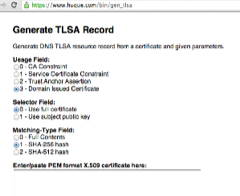 Would you like to use the DANE protocol to secure your SSL/TLS certificate via DNSSEC? If so, the first step is to generate and publish a “TLSA record” in DNS – and that record generation can be a stumbling block for some people. While there are command-line tools such as just the basic “openssl” or Paul Wouter’s “hash-slinger“, Shumon Huque recently released a web interface that lets you easily create a TLSA record. As Shumon writes about on his blog, the tool is at:
Would you like to use the DANE protocol to secure your SSL/TLS certificate via DNSSEC? If so, the first step is to generate and publish a “TLSA record” in DNS – and that record generation can be a stumbling block for some people. While there are command-line tools such as just the basic “openssl” or Paul Wouter’s “hash-slinger“, Shumon Huque recently released a web interface that lets you easily create a TLSA record. As Shumon writes about on his blog, the tool is at:
All you need to do is to set the type of TLSA record you want to create, paste in the X.509 certificate, and enter the appropriate port number, protocol and domain name. Shumon’s script then generates the appropriate TLSA record that you can paste into your DNS zone file.
Last year, Shumon wrote a post on “DNSSEC and Certificates” where he walked through how to do this using openssl on the command line – this latest post now builds on that to make it even easier.
It’s excellent that Shumon has made this tool available and we look forward to seeing many more TLSA records out there! (If you have a SSL/TLS cert for your website, how about adding a TLSA record today?)
